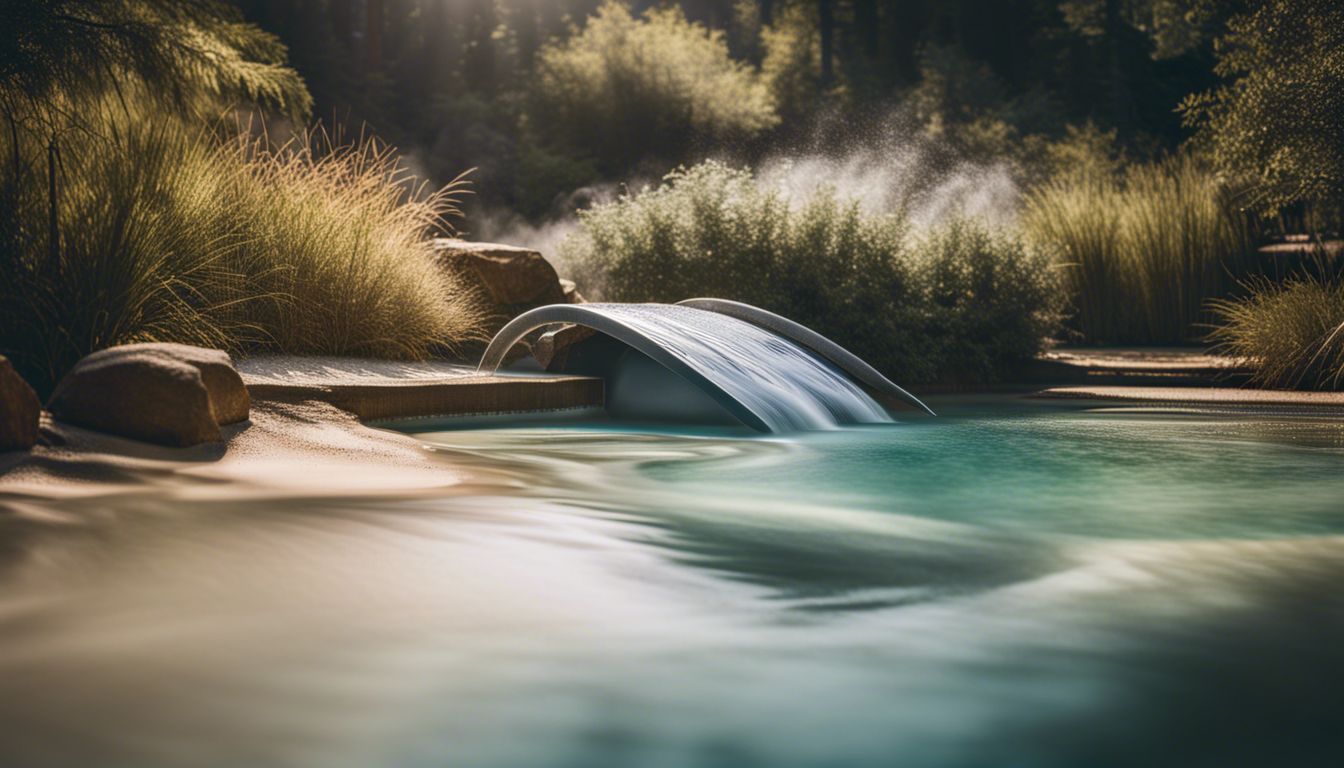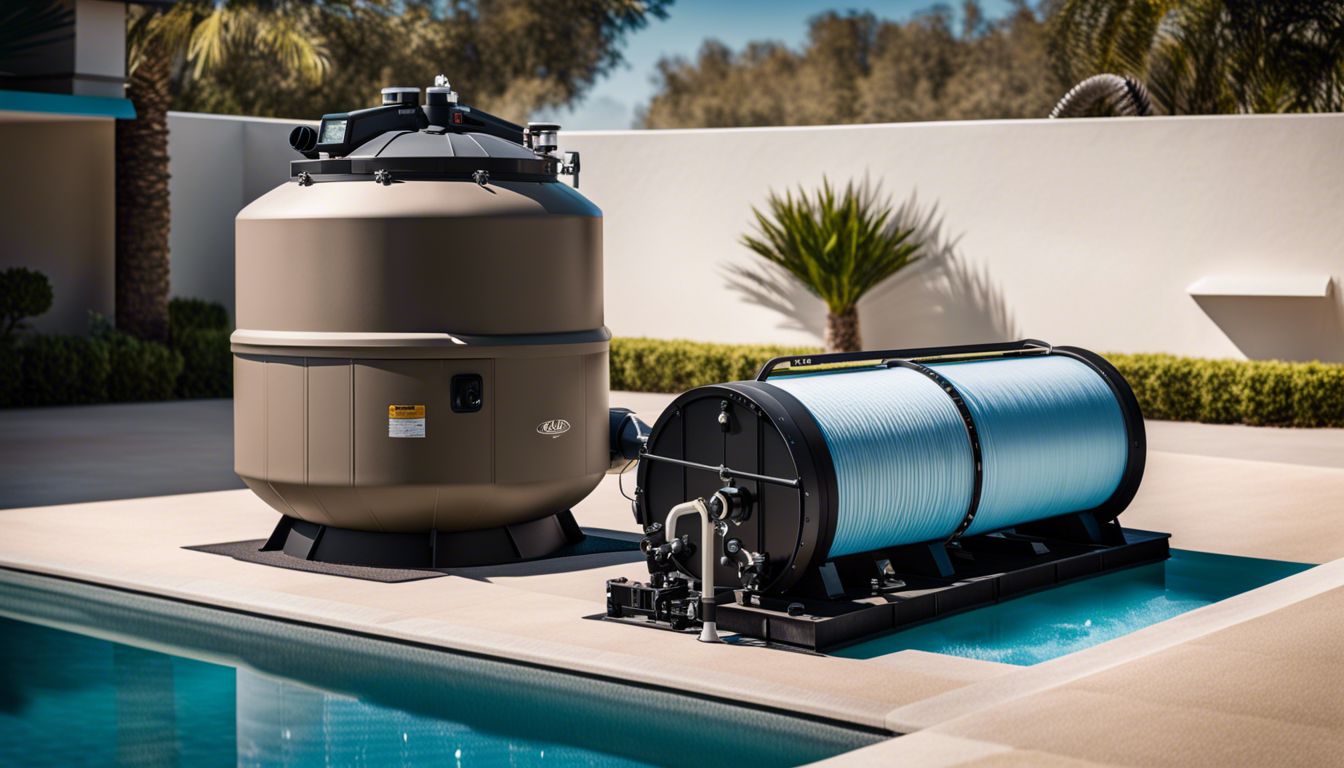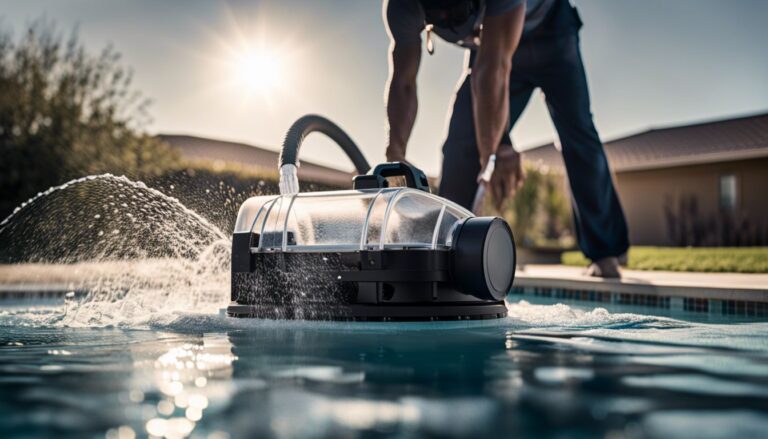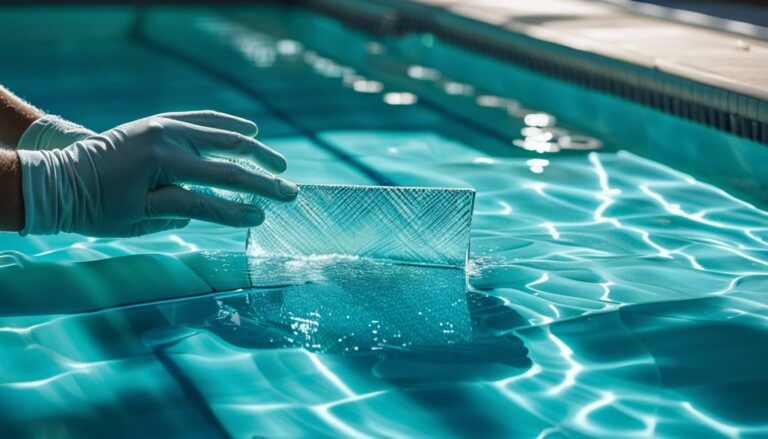How To Clean A Pool Sand Filter: 2023 Guide
How To Clean A Pool Sand Filter
Keeping your swimming pool crystal clear can often be challenging, particularly when your sand filter gets dirty. Did you know that a sand filter can last up to 25 years with regular cleaning and maintenance? This article will walk you through the step-by-step process of cleaning a pool sand filter effortlessly and efficiently.
Ready to dive in? Let’s get started!
Key Takeaways
- Regular cleaning and maintenance of a pool sand filter can help it last up to 25 years.
- Common issues with pool sand filters include high filter pressure, slow filtration rate, leaks in the multiport valve, broken or bad laterals, and accumulation of calcium deposits or organic matter.
- Signs that your pool sand filter needs cleaning include high or low filter pressure, dirty or cloudy water, slow filtration rate, leaks around components, flat or compacted sand bed, and frequent backwashing.
- It is recommended to clean your pool sand filter every 2 – 3 years and perform deep cleaning at least once a year. Backwashing should be done regularly based on the level of contamination in your pool water.
Understanding Your Pool Sand Filter
A pool sand filter traps dirt and debris in the sand bed, allowing clean water to flow back into the pool.
How a pool sand filter works
 A pool sand filter is a versatile tool that keeps your swimming area clean and safe by capturing fine debris. It operates on a simple yet effective mechanism. The filter consists of an internal plumbing system surrounded by sand packed inside the tank, constituting about 60% of its volume.
A pool sand filter is a versatile tool that keeps your swimming area clean and safe by capturing fine debris. It operates on a simple yet effective mechanism. The filter consists of an internal plumbing system surrounded by sand packed inside the tank, constituting about 60% of its volume.
The sand catches and removes unwanted contaminants as pool water passes through this tank. This efficient functioning ensures consistently clear water while maintaining its flow rate effectively.
However, like all devices, regular maintenance – such as backwashing to flush out trapped debris – is key to keeping it working at peak performance levels for longer periods; thus making your investments worthwhile.
How To Clean A Pool Sand Filter: Common Issues

Knowing your pool sand filter can help you maintain it for optimal performance. A variety of problems could occur; here are some of the most common issues:
- High filter pressure is a prevalent issue often arising from a dirty filter. Lack of regular cleaning can lead to an accumulation of debris in the filter, resulting in increased pressure.
- If your sand filter seems slow, it could be because the sand is old or worn out. This usually results in ineffective water filtration, affecting your swimming pool’s cleanliness.
- Multiport valves on a pool sand filter can sometimes leak. These leaks may cause decreased water flow and overall inefficiency.
- Broken or bad laterals inside the sand pool filter tank also result in problems. They can allow small particles and debris back into the pool instead of trapping them.
- Sometimes, channels may form in the sand bed due to continuous use; this phenomenon is known as “channeling.” It leads to poor filtration since water bypasses the normal operating level of sand and reduces its effectiveness.
- Accumulation of calcium deposits on top of the filter – also known as calcified sand – hampers its performance too.
- Mudballing or gunking up occurs when organic matter accumulates within your filter media, specifically pool filter sand – leading to reduced efficiency.
- Improper backwashing and irregular flow can bring about poor water quality or fill up your sand filter with caliche, a rock-like material that impedes proper functioning.
- Using bad or old pool sand also paves the way for slow filtration – it needs regular cleaning or replacement for efficient operation.
- If greasy substances enter your swimming pool, they will likely dirty up your pool filter cartridge with time, significantly reducing its filtration ability.
- Despite all efforts at cleaning, the sand filters still don’t function optimally, you might need to check your pump for clogged impellers or bad bearings causing malfunctions.
When to Clean Your Pool Sand Filter
Knowing when to clean your pool sand filter is crucial for maintaining its effectiveness. Look out for signs such as decreased water flow, higher than usual pressure on the gauge, and cloudy or dirty water indicating that it’s time for a cleaning.
Regular cleaning every 2-3 years is recommended, but frequency may vary depending on usage and chemical treatments.
Signs that your pool sand filter needs cleaning
 Pool owners often ask, “How do I know when my pool sand filter needs cleaning?” The following signs can help you detect potential problems that may require a thorough cleaning of your sand filter:
Pool owners often ask, “How do I know when my pool sand filter needs cleaning?” The following signs can help you detect potential problems that may require a thorough cleaning of your sand filter:
- High filter pressure: A high reading on your pressure gauge clearly indicates that your sand filter needs attention. It indicates that the water flow through the filter has been reduced due to accumulated dirt and debris.
- Low filter pressure: On the flip side, low pressure can also indicate an issue with your sand filter. If it drops below ten psi, blockages could slow the water flow.
- Dirty or cloudy water: One of the most evident signals is when your swimming pool begins to have cloudy or dirty water, despite running your pool pump regularly.
- Slow filtration rate: If you observe that it’s taking longer than usual for the water to cycle through the system, it could mean that there are obstructions within the sand bed of your sand pool filter.
- Leaks around components: Another visual clue is if there are leaks around multiport valves or other parts of the sand filter system.
- Flat or compacted sand bed: When inspecting your pool sand filter, if part or all of the top of the filter’s silica bed looks flat, hard, and unraised compared to its normal operating level, this could indicate a need for cleaning.
- Need for frequent backwashing: If you notice that you need to carry out a backwash process more frequently than usual – say every week instead of every month – this could be a sign of clogged pores in the silica sand used as filter media in pool filtration systems.
Recommended cleaning frequency
To keep your pool water clean and clear, cleaning your pool sand filter regularly is important. The recommended cleaning frequency for a pool sand filter is once every month. This will help maintain optimal filtration efficiency and prevent any build-up of dbuildup contaminants.
Additionally, it is advisable to perform a deep cleaning of the filter at least once a year to ensure its longevity and effectiveness. By following these maintenance steps, you can prolong the lifespan of your pool sand filter and enjoy crystal-clear water all summer long.
Steps to Clean a Pool Sand Filter
To clean a pool sand filter, first, turn off the pump and move the valve to the “backwash” position.
Backwashing the filter
It’s important to regularly backwash your pool sand filter to keep your pool water clean and clear. Backwashing is a simple process that reverses the water flow through the filter to remove built-up contaminants.
This restores the cleaning power of the filter and helps maintain optimal water quality. By connecting a backwash hose to the filter and following a few easy steps, you can ensure that your pool stays crystal clear all season long.
Remember, backwashing should be done periodically based on the level of contamination in your pool water, so it’s an essential part of regular pool maintenance for every pool owner.
Adding filter cleaning solution
To enhance the cleaning process and improve the efficiency of your pool sand filter, it’s recommended to add a filter cleaning solution. This can help remove stubborn contaminants and keep your filter in good shape.
After backwashing your sand filter, turn off the pump and switch the valve to “Filter” before adding the cleaning solution. Remove the pump’s strainer lid to access the sand filter cleaner, a commercial product or a homemade alternative.
Adding the appropriate cleaning solution will help ensure clear water and prevent clogging or damage to your pool equipment.
Performing a final rinse
After completing the cleaning process for your pool sand filter, it’s important to perform a final rinse to ensure everything is in proper working order. To do this, turn the filter lever to the “rinse” setting and run the pump for about 15-30 seconds.
This will flush out any remaining debris or cleaner residue from the system before returning to normal operation. Once the rinse is complete, remember to turn the lever back to the “filter” setting.
Regular maintenance of your sand filter, including performing a final rinse after cleaning, is crucial in keeping your pool water clean and clear all season long.
Maintenance Tips for Pool Sand Filters
 To ensure your pool sand filter remains in good shape, regularly inspect and maintain it by checking the pressure gauge, cleaning the pump lid, and ensuring proper storage during the off-season.
To ensure your pool sand filter remains in good shape, regularly inspect and maintain it by checking the pressure gauge, cleaning the pump lid, and ensuring proper storage during the off-season.
Regular inspections and maintenance
 Regular inspections and maintenance are crucial for keeping your pool sand filter in good shape and ensuring a clean swimming pool. By performing visual inspections inside the filter, completing backwashing cycles, and checking water flow from the pump, you can identify potential issues early on and prevent them from becoming major problems.
Regular inspections and maintenance are crucial for keeping your pool sand filter in good shape and ensuring a clean swimming pool. By performing visual inspections inside the filter, completing backwashing cycles, and checking water flow from the pump, you can identify potential issues early on and prevent them from becoming major problems.
Regular maintenance also helps prolong your pool components’ life, saving you money in the long run. It is recommended to deep-clean your filter at least once a year, depending on your filter type.
By staying on top of regular inspections and maintenance, you can enjoy a cleaner pool with clear water all season long.
Proper storage during the off-season
Proper storage during the off-season is crucial for maintaining the longevity and performance of your pool sand filter. By taking a few simple steps, you can ensure that your filter stays in good shape and is ready to go when swimming season rolls around again.
The first step is to turn off the pool pump and drain water from the system. Next, cover the filter to protect it from debris and harsh weather conditions. This will help prevent any damage or clogging while it’s not in use.
Finally, store the filter in a clean, dry area without exposure to extreme temperatures or moisture. Following these steps will help extend the lifespan of your sand filter and keep it working efficiently year after year.
Troubleshooting common problems
 Are you experiencing issues with your pool sand filter? Here are some common problems you might encounter and how to troubleshoot them:
Are you experiencing issues with your pool sand filter? Here are some common problems you might encounter and how to troubleshoot them:
- Leaking multiport valve: Check the valve for any cracks or damaged seals. Replace any faulty parts or gaskets to fix the leak.
- Clogged impeller: A clogged impeller can cause low flow and pressure in your pool sand filter. Remove the pump lid and inspect the impeller for any debris or blockages. Clean it thoroughly to restore proper flow.
- Sand blowing out of the filter: This could be caused by a broken lateral or a damaged sand filter bed. Inspect the laterals for cracks or damage, and replace them if necessary. If the sand bed is worn out, it may need to be replaced entirely.
- Inadequate filtration of fine particles: If your pool water is still cloudy despite running the filter, it could be due to fine particles passing through the sand. Consider using a clarifier or adding a flocculant to help improve filtration efficiency.
- High sand filter pressure: High pressure can indicate a clog in the system or other issues like calcified sand, mudballs, or gunk buildup. Backbuildupe filter and inspect for any blockages in the skimmer basket, pump pot, or plumbing lines.
- Slow filtration: If water is not flowing through your pool sand filter as quickly as it should, check for obstructions in the plumbing lines, such as leaves or debris. Clear any blockages to restore proper water flow.
- Leaks from seams or bottom of the filter: Inspect all connections and joints for signs of leaks. Tighten loose bolts and replace faulty gaskets or O-rings that may be causing leaks.
- Algae growth despite filtration: If algae are still present in your pool even after running your sand filter, it could be due to inadequate filtration or an improper balance of chemicals. Adjust your water chemistry and consider adding algaecide to prevent further growth.
Conclusion
 In conclusion, knowing how to clean a pool sand filter is essential for maintaining a clean and healthy swimming pool. By understanding the workings of your sand filter, recognizing when it needs cleaning, and following the proper steps, you can ensure optimal filtration performance.
In conclusion, knowing how to clean a pool sand filter is essential for maintaining a clean and healthy swimming pool. By understanding the workings of your sand filter, recognizing when it needs cleaning, and following the proper steps, you can ensure optimal filtration performance.
Regular maintenance and inspections will also help prolong the lifespan of your sand filter. With these simple steps and tips, you can keep your pool crystal clear all season.
FAQs
1. How often should I clean my pool sand filter?
A general rule for cleaning pool sand filters is to do so at least once every season. However, this frequency may increase depending on the usage and condition of your pool. A sharp increase in the pressure gauge, typically 8-10 psi over the clean starting pressure, could indicate it’s time for a clean. It’s a good idea to keep a close eye on your filter’s performance to decide the appropriate time for a cleaning.
2. What materials do I need to clean a pool sand filter?
You’ll need a few key tools to clean a pool sand filter: a backwash hose, a pressure gauge, and a pool filter cleaner or detergent. If your filter requires a sand change, you’ll also need access to a garden hose for rinsing and potentially new sand. Lastly, it’s recommended to have a bucket of clean water on hand for rinsing off various components.
3. Can I clean my pool sand filter, or do I need professional help?
Cleaning a pool sand filter is a task that many pool owners can carry out themselves. Many resources, like this simple step-by-step guide, can walk you through the process. However, it might be best to turn to a professional for assistance if you’re a new pool owner or having difficulty with the process.
4. How long does it take to clean a pool sand filter?
The time it takes to clean a pool sand filter can vary. Factors like the size of your filter, the type of pool filter you have (e.g., DE filter or sand filter), and the level of dirt buildup can ibuildupe the cleaning duration. It may take anywhere from 30 minutes to a couple of hours on average. Remember, it’s not just about time; ensuring the job is done well is the most important aspect.
5. What’s the best way to add new sand to my pool filter?
Adding new sand to your pool filter involves a few key steps. First, ensure your pump is turned off and the drain plug removed to empty old water and sand. Once the filter tank is cleaned, add the new sand carefully, keeping the center pipe steady. Avoid overfilling the tank; generally, fill it to around two-thirds full. Replace the drain plug and reassemble your filter, ready for the next round of filtration.
6. How can I ensure the clean water level in my pool after cleaning my sand filter?
Following a filter clean, your pool water level may need adjusting. Please turn on your pool’s water supply or add water with a garden hose to return the level to its normal operating range. The ideal water level is typically halfway up your pool skimmer. Maintaining a proper water level ensures the optimal operation of your pool’s filtration system.
7. How can I avoid a cloudy pool after cleaning my sand filter?
After cleaning your sand filter, a cloudy pool can be caused by residual debris or the release of finer sand particles. One of the best ways to avoid this is by running your pool pump on a backwash cycle for a few minutes following a clean. This will help to flush out any remaining particles and ensure the cleanliness of your pool water.
8. Is a DE filter better than a sand filter for my pool?
Choosing between a DE (Diatomaceous Earth) filter and a sand filter depends on your specific needs and circumstances. DE filters are known for their ability to filter out smaller particles, providing a higher level of filtration. However, they can require more maintenance than sand filters. Sand filters, however, are often praised for their ease of use and longevity. It’s a good idea to research both options and consider factors such as your pool usage, budget, and maintenance preference before deciding.






